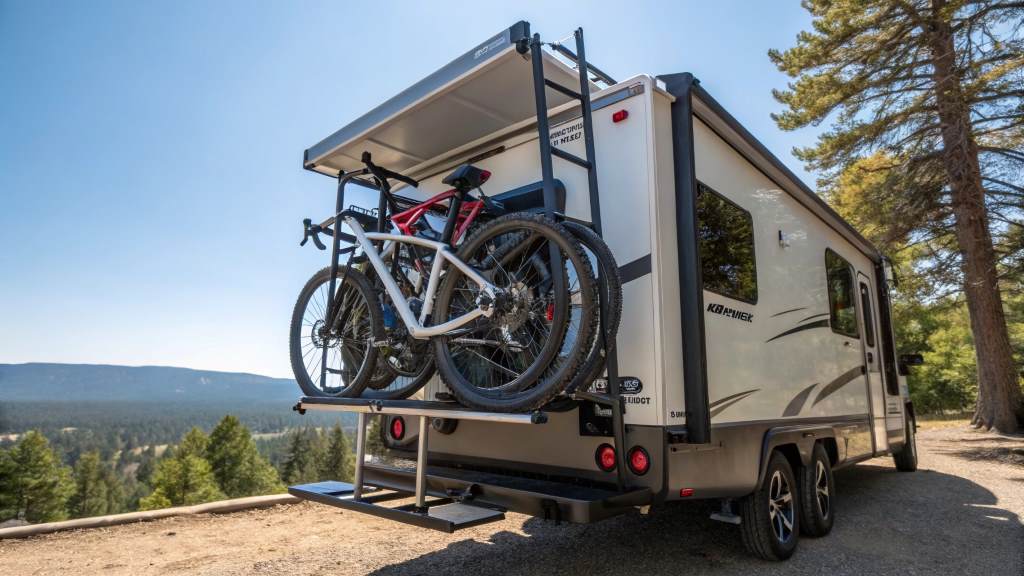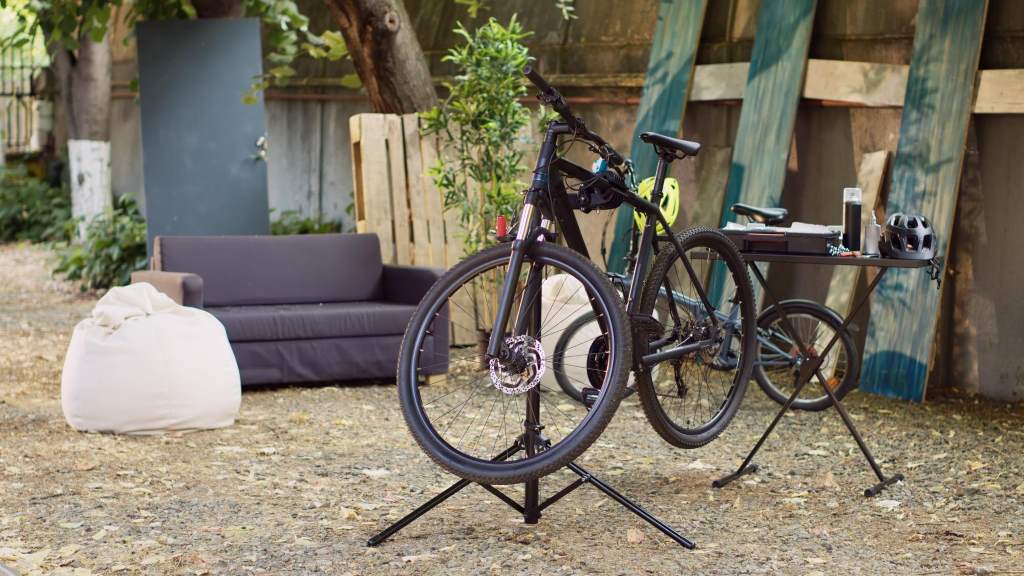Pop-up campers offer a fantastic blend of tent-like immersion and hard-sided comfort, making them a popular choice for outdoor enthusiasts. But what about bringing your bikes along? The question of whether you can install a bike rack on a pop-up camper is a common one, and the answer, while generally yes, comes with nuances and considerations. This comprehensive guide will delve into the various options, safety measures, and practical tips to help you transport your bikes securely and enjoy your cycling adventures on the road.
Understanding the Challenges: Weight, Stability, and Mounting Surfaces
The primary challenge with adding a bike rack to a pop-up camper lies in its inherent design. These campers are built with lightweight materials to facilitate easy towing and setup. This lightness, however, translates to limitations in weight capacity and structural integrity. Unlike a solid-bodied travel trailer, a pop-up camper features a collapsible roof and canvas sides, making traditional mounting points less robust.
Furthermore, the rear bumper of a pop-up camper is often not designed to handle the added weight and stress of a bike rack and multiple bikes. The instability introduced by the bouncing weight of bikes during travel can lead to damage to the camper’s frame, the rack itself, and even pose a safety hazard on the road. Therefore, a careful assessment of your camper’s specifications and a thoughtful approach to installation are crucial.

Exploring Different Bike Rack Options: From Tongue-Mounted to Roof-Based Solutions
Several bike rack options can potentially work with a pop-up camper, each with its own pros and cons.
Tongue-Mounted Bike Racks:
- These racks mount onto the A-frame of the camper’s tongue, the triangular structure that connects the camper to the tow vehicle.
- Pros: They generally offer a stable mounting point, as the tongue is designed to handle significant weight. They also keep the bikes out of the way of the rear of the camper, allowing for easy access to the storage compartment.
- Cons: They add length to the overall rig, which can make maneuvering and parking more challenging. They can also interfere with the turning radius of the tow vehicle, especially in tight spaces. Weight distribution is crucial; too much weight on the tongue can negatively affect towing stability. Ensure the tongue weight remains within the manufacturer’s specified limits.
- Installation Considerations: Verify the A-frame’s strength and compatibility with the chosen rack. Use high-quality, heavy-duty hardware and ensure the rack is securely fastened. Consider a rack designed for travel trailers or campers, as these are often more robust.
Roof-Mounted Bike Racks (With Caution):
- While technically possible, roof-mounted racks are generally discouraged for pop-up campers. The roof is typically not designed to support the weight of bikes and the rack itself.
- Pros: Keeps the bikes completely out of the way.
- Cons: Significant risk of damaging the roof, especially during setup and takedown. Lifting bikes onto the roof can be challenging and potentially dangerous. Increased wind resistance can affect fuel efficiency. The added weight high up can negatively affect the campers stability while driving.
- If you must: If you choose this method, only carry very light bikes, and ensure the rack is compatible with the roof’s structure. Reinforce the roof if possible, and use extreme caution during installation and loading.
Receiver Hitch Mounted Bike Racks (Tow Vehicle):
- This is often the safest and most practical option. Instead of mounting the rack on the camper itself, you install a receiver hitch on your tow vehicle and use a hitch-mounted bike rack.
- Pros: Distributes the weight evenly on the tow vehicle, minimizing stress on the camper. Easy access to the bikes. Wide variety of hitch-mounted racks available.
- Cons: Requires a receiver hitch on the tow vehicle. Can add length to the overall rig.
- Installation Considerations: Ensure the receiver hitch is properly installed and rated for the weight of the rack and bikes. Choose a high-quality hitch-mounted rack that is designed for travel.
Bumper Mounted Racks (Generally Not Recommended):
- While some might consider this option, it is generally not recommended for pop-up campers. The rear bumpers are often not strong enough to handle the weight and stress of a bike rack.
- Pros: Seemingly a simple solution.
- Cons: High risk of damage to the bumper and camper frame. Potential for instability and safety hazards.
- Avoid: Unless you have a heavily reinforced bumper and are carrying very light bikes, this option is best avoided.
Safety Considerations: Ensuring a Secure and Stable Setup
Regardless of the chosen option, safety should be the top priority.
- Weight Distribution: Carefully distribute the weight of the bikes and rack. Ensure the tongue weight remains within the manufacturer’s specifications.
- Secure Fastening: Use high-quality, heavy-duty hardware and ensure the rack is securely fastened to the mounting point.
- Regular Inspections: Regularly inspect the rack, hardware, and mounting points for any signs of wear or damage.
- Straps and Tie-Downs: Use high-quality straps and tie-downs to secure the bikes to the rack.
- Clearance: Ensure the bikes do not obstruct the taillights, license plate, or rear view.
- Test Drive: Before embarking on a long trip, take a test drive to ensure the rack and bikes are stable and secure.
- Camper Leveling: When parked, ensure the camper is level to prevent unnecessary stress on the rack and mounting points.
- Consider Bike Weight: Heavy electric bikes can be too much for many pop up campers. Lighter bikes are always better.
People Also Ask (FAQs):
Q: Can I put a hitch on my pop-up camper?
A: While some pop-up campers might have a factory-installed hitch, many don’t. Aftermarket hitches can be installed, but it’s crucial to ensure the frame is strong enough to support the added weight and stress. Consult with a professional installer and verify the camper’s specifications.
Q: How much weight can a pop-up camper bumper hold?
A: Generally, pop-up camper bumpers are not designed to hold significant weight. It’s best to avoid mounting anything heavy on the bumper. Consult the manufacturer’s specifications for specific weight limits.
Q: Can I put a bike rack on the back of my pop-up camper?
A: While possible, it’s generally not recommended due to the limited strength of the rear bumper. Tongue-mounted or hitch-mounted racks are safer and more practical options.
Q: Will adding a bike rack affect my pop-up camper’s warranty?
A: Modifications to your camper, including adding a bike rack, can potentially void your warranty. Contact the manufacturer or your dealer to clarify the warranty terms.
Q: What is the best type of bike rack for a pop-up camper?
A: A tongue-mounted or hitch-mounted rack on the tow vehicle are generally the best options. They provide a stable and secure platform for transporting your bikes.
Conclusion: Planning and Safety for Cycling Adventures
Transporting bikes with a pop-up camper requires careful planning and a focus on safety. While adding a bike rack to the camper itself can be challenging, tongue-mounted racks or hitch-mounted racks on the tow vehicle offer viable solutions. By understanding the limitations of your camper, choosing the right rack, and prioritizing safety, you can enjoy the freedom of cycling on your outdoor adventures. Always consult with professionals and prioritize safety above all else. With the right setup, you can confidently bring your bikes along for your pop-up camping experiences, enhancing your outdoor adventures and creating lasting memories.

Taylor is an outdoors & sports equipment specialist, sports author, bike traveler, bicycling and skating expert, and smoke-free ride activist. He is also a regular reviewer of outdoor sports gadgets and accessories. About safety gear and biking facts he analyzes and gives his feedback to outdoorxsports. Writes and tests to help him, you, and us.

